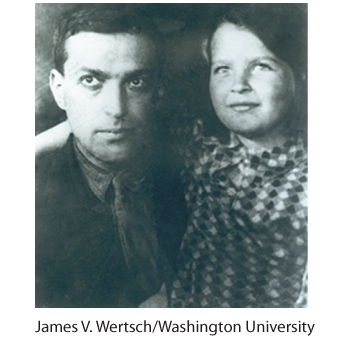An Alternative Viewpoint: Lev Vygotsky and the Social Child
As Piaget was forming his theory of cognitive development, Russian psychologist Lev Vygotsky was also studying how children think and learn. Where Piaget emphasized how the child’s mind grows through interaction with the physical environment, Vygotsky emphasized how the child’s mind grows through interaction with the social environment. If Piaget’s child was a young scientist, Vygotsky’s was a young apprentice. By giving children new words and mentoring them, parents and teachers provide what we now call a temporary scaffold from which children can step to higher levels of thinking (Wood et al., 1976).

Lev Vygotsky (1896–1934) Vygotsky, pictured here with his daughter, was a Russian developmental psychologist. He studied how a child’s mind feeds on the language of social interaction.

“It’s too late, Roger—they’ve seen us.”
Roger has not outgrown his early childhood egocentrism.
Effective mentoring occurs when children are developmentally ready to learn a new skill. For Vygotsky, a child’s zone of proximal development is the zone between what a child can and can’t do—it’s what a child can do with help. When learning to ride a bike, it’s the developmental zone in which a child can ride with training wheels or a steadying parental hand. Children learn best when their social environment presents them with something in the sweet spot between too easy and too difficult.
Language, an important ingredient of social mentoring, provides the building blocks for thinking, noted Vygotsky (who was born the same year as Piaget, but died prematurely of tuberculosis). By age 7, children increasingly think in words and use words to solve problems. They do this, Vygotsky said, by internalizing their culture’s language and relying on inner speech (Fernyhough, 2008). Parents who say, “No, no, Bevy!” when pulling her hand away from a cup of hot coffee are giving their child a self-control tool. Second graders who muttered to themselves while doing math problems grasped third-grade math better the following year (Berk, 1994). Whether out loud or inaudibly, talking to themselves helps children control their behavior and emotions and master new skills. (It helps adults, too. Adults who motivate themselves using self-talk—“You can do it!”—experience better performance [Kross et al., 2014].)